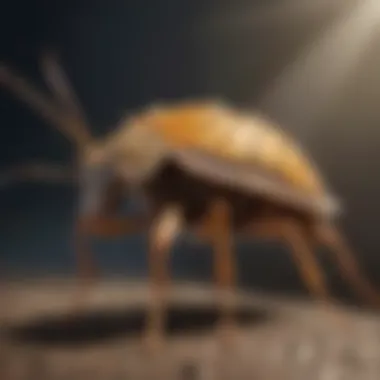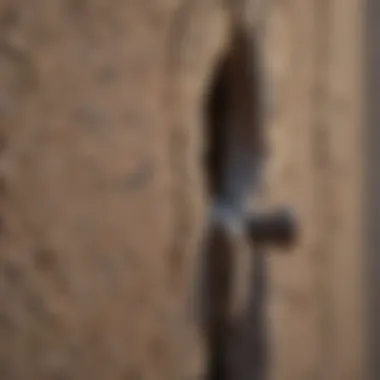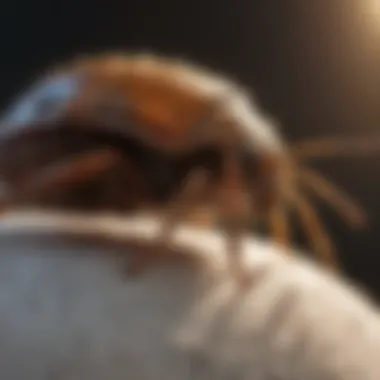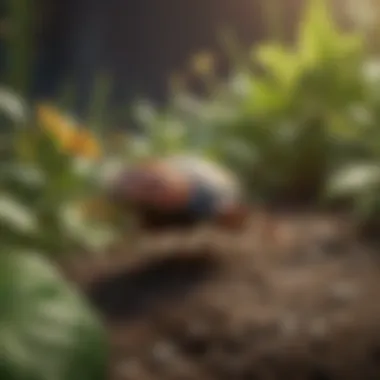Effective Ways to Safely Get Rid of Stink Bugs from Your Home


Preventive Pest Control Strategies
When it comes to safeguarding your home against stink bugs and other pesky invaders, employing preventive pest control strategies is paramount. Your first line of defense begins with fortifying your house's exterior. Seal all cracks and crevices meticulously, as these tiny openings serve as prime entry points for unwanted guests. Remember, even the smallest gap can provide easy access to these resilient intruders. Additionally, clearing debris around your property is vital to eliminate potential hiding spots for pests. By keeping your house exterior tidy and well-maintained, you create a less hospitable environment for stink bugs.
In conjunction with fortifying your home's exterior, maintaining your yard plays a crucial role in pest prevention. Regular yard care routines such as mowing the lawn, trimming bushes, and removing overgrown vegetation contribute significantly to reducing pest harborage areas. Implement methods like removing standing water sources and keeping firewood piles away from the house to minimize attractive habitats for stink bugs.
Indoor cleanliness is another key aspect of effective pest control. Dusting and vacuuming regularly not only enhances the aesthetics of your home but also eliminates potential shelter areas for pests. Practice proper waste management by promptly disposing of garbage in sealed containers and ensuring bins are kept clean. By incorporating these simple yet effective indoor cleaning tips, you create an environment that is less appealing to stink bugs and other unwanted critters.
Proper garbage disposal is often an overlooked aspect of pest prevention. By efficiently disposing of waste and maintaining sanitary conditions, you not only deter stink bugs but also prevent other pests from being attracted to your home. Remember, good sanitation practices go a long way in creating a pest-resistant living space.
In addition to these fundamental preventive measures, exploring innovative ways to safeguard your home against pests is essential. From installing physical barriers like door sweeps and window screens to utilizing natural repellents such as neem oil and citrus sprays, there are various strategies you can employ to bolster your defenses against stink bugs and other pests.
Understanding Stink Bugs
In the realm of pest control, understanding the behavior and biology of stink bugs is pivotal. These odorous insects, scientifically known as Pentatomidae, often seek refuge indoors, disrupting the sanctity of homes. Delving into the intricacies of stink bug habits enables homeowners to formulate effective strategies for eradication. By comprehending their attraction to warmth and shelter, individuals can proactively fortify their dwellings against potential invasions. Knowledge about stink bugs equips residents with the foresight to anticipate infestations and the tools to combat them efficiently.
What are Stink Bugs?
Stink bugs, characterized by their shield-shaped bodies and distinct odor, are native to Asia but have now made their presence known worldwide. These agricultural pests feed on plant juices, causing damage to crops and ornamental plants. Their penchant for congregating in large numbers amplifies the nuisance they pose. When threatened or squashed, stink bugs emit a foul-smelling odor, hence their name. Recognizing these insects is crucial for implementing targeted control measures and safeguarding residential spaces from their intrusion.
Why Do Stink Bugs Enter Homes?


The invasion of stink bugs into homes is orchestrated by survival instincts and seasonal changes. During the cooler months, stink bugs seek warmth and protection indoors to weather harsh environmental conditions. The structural crevices and openings in houses offer ideal entry points for these pests. Furthermore, the allure of food sources within homes incentivizes their migration. Understanding the drivers behind stink bug entry aids in fortifying residences against infestations. By addressing vulnerabilities and eliminating attractants, homeowners can effectively repel these unwelcome visitors.
Preventative Measures
In the battle against stink bugs infiltrating your home, implementing Preventative Measures stands as a crucial first line of defense. These proactive strategies not only deter stink bugs from entering but also help in maintaining a bug-free environment. By fortifying your home against these pesky invaders, you can save yourself from the incessant bother of dealing with stink bugs and their unpleasant odor. Preventative Measures play a pivotal role in the overall management of stink bug infestations, offering long-term solutions rather than just temporary fixes.
Sealing Entry Points
One of the most effective ways to prevent stink bugs from invading your home is by sealing off their entry points. Stink bugs can wiggle through minute openings and cracks in walls, windows, and doors, making it imperative to meticulously inspect and seal any potential entryways. By using caulk, weather stripping, or sealants, you can block these tiny intruders from finding their way inside. Regularly checking and maintaining the integrity of your home's structure is essential in keeping stink bugs at bay.
Repairing Screens and Gaps
Stink bugs can sneak into your home through damaged screens or gaps in windows and doors. To combat this, repairing screens and sealing gaps becomes a vital task in stink bug prevention. Patch up any holes or tears in window screens and promptly fix any gaps or crevices in door frames. Maintaining a vigilant stance on screening and repairing these potential entry points ensures a formidable barrier against stink bug infiltration.
Installing Door Sweeps
Door sweeps act as an additional layer of defense against stink bugs and other pests trying to gain entry through the gap between the door and the floor. By installing door sweeps, you create a tight seal that prevents stink bugs from crawling underneath and entering your home. Choose door sweeps made from durable materials that can withstand daily wear and tear. Implementing this simple yet effective measure significantly reduces the chances of stink bugs finding their way inside, contributing to a stink bug-free living space.
Natural Remedies
In the realm of stink bug extermination, natural remedies stand as stalwart allies against these pesky intruders. Embracing natural solutions not only aids in combating stink bugs effectively but also minimizes the use of harmful chemicals within our living spaces. This section sheds light on the various natural remedies that housewives and homeowners can employ to rid their homes of stink bugs, fostering a safer and eco-friendly environment. Understanding the significance of natural remedies is pivotal in creating a holistic approach to pest control, which resonates with the discerning audience sought by this article.


Using Essential Oils
Essential oils emerge as potent weapons in the battle against stink bugs, harnessing the power of nature's aromatic essences to repel these unwelcome guests. Housewives and homeowners can leverage essential oils like peppermint, lavender, or eucalyptus to create barrier sprays that deter stink bugs from infiltrating living spaces. Moreover, the pleasant fragrance they emit serves as a refreshing alternative to chemical-laden insecticides, offering a natural and inviting scent within the home. Diligently applying these essential oils around entry points and susceptible areas acts as a formidable defense mechanism, preventing stink bugs from encroaching on your sanctuary.
Creating DIY Traps
Crafting do-it-yourself traps presents a creative and efficient strategy for trapping and removing stink bugs without resorting to harmful chemicals. By using common household items like empty plastic bottles, LED lights, and dish soap, housewives and homeowners can set up traps to lure and capture stink bugs effectively. These traps not only aid in reducing the stink bug population within the home but also offer a practical and cost-effective solution to combat infestations. Implementing DIY traps aligns with the ethos of sustainable living and personal involvement in pest control, resonating with individuals seeking eco-conscious practices.
Utilizing Beneficial Insects
Harnessing the power of nature's allies, beneficial insects play a crucial role in controlling stink bug populations in an environmentally friendly manner. Introducing beneficial insects like ladybugs or lacewings into your outdoor spaces can help maintain a natural balance and mitigate stink bug invasions effectively. These predatory insects feed on stink bug larvae and eggs, curtailing their proliferation and safeguarding your home from potential infestations. Embracing the concept of biological pest control underscores the interconnectedness of ecosystems and showcases a sustainable approach to pest management, resonating with individuals concerned about environmental impact and seeking natural solutions.
Chemical Control Methods
Chemical control methods play a crucial role in effectively combating stink bug infestations in your home. By utilizing targeted chemical measures, you can efficiently manage and eliminate these pesky insects. Chemical control methods should be integrated as part of a comprehensive stink bug management strategy to achieve optimal results. Emphasizing the strategic application of chemical solutions helps in eradicating stink bugs and preventing future infestations.
Insecticidal Sprays
Insecticidal sprays are potent chemical formulations specifically designed to kill stink bugs on contact. These sprays contain active ingredients that target the nervous system of stink bugs, effectively exterminating them. When using insecticidal sprays, it is essential to follow instructions carefully to ensure safety and efficacy. Consider using insecticidal sprays in areas where stink bugs are most active, such as entry points or feeding sites. Regular application of insecticidal sprays can control stink bug populations and minimize their presence in your home.
Diatomaceous Earth


Diatomaceous earth is a natural and non-toxic powder that can be used to eliminate stink bugs. This fine powder consists of fossilized diatoms and functions by dehydrating and damaging the exoskeleton of stink bugs upon contact. Diatomaceous earth should be applied in thin layers around entry points and potential hiding spots of stink bugs. Due to its mechanical action, diatomaceous earth provides a physical barrier that deters stink bugs from entering your living space. Regular application of diatomaceous earth can disrupt stink bug infestations and prevent reoccurrences effectively.
Pyrethroid-Based Products
Pyrethroid-based products are synthetic chemical pesticides commonly used for stink bug control. These products contain pyrethroids, a class of insecticides that disrupt the nervous system of stink bugs, leading to paralysis and eventual death. Pyrethroid-based products come in various formulations such as sprays or dusts for convenient application. When using pyrethroid-based products, ensure proper ventilation and follow safety guidelines to prevent exposure. Incorporating pyrethroid-based products into your stink bug management plan can assist in eradicating existing populations and deterring future infestations.
Professional Extermination Services
Professional extermination services come into play when stink bug infestations become overwhelming, and DIY methods have proven ineffective. Expert pest control technicians have the knowledge, tools, and experience to tackle stink bug problems efficiently. By entrusting the job to professionals, homeowners can benefit from a thorough and lasting solution that ensures the complete eradication of stink bugs from their premises. Additionally, professional services offer a level of expertise that goes beyond what individuals can achieve on their own.
When to Seek Professional Help
Knowing when to seek professional help for stink bug infestations is crucial. If DIY strategies have not yielded the desired results or if the infestation is extensive, it is advisable to contact professional exterminators. Signs such as a sudden surge in stink bug sightings, an overpowering odor, or visible damage to property indicate the need for expert intervention. Prompt action can prevent the situation from escalating, safeguarding the home and its inhabitants from the nuisances caused by stink bugs.
Choosing the Right Exterminator
Selecting the right exterminator for stink bug control requires careful consideration. Homeowners should opt for licensed and experienced professionals who specialize in dealing with stink bug infestations. Requesting references, reading reviews, and checking for certifications can help assess the credibility of the extermination service. Moreover, choose environmentally conscious exterminators who use effective yet eco-friendly methods to eliminate stink bugs. By making an informed choice, homeowners can ensure a successful and sustainable outcome in combating stink bugs.
Maintaining a Stink Bug-Free Home
In this pivotal section of our comprehensive guide on eliminating stink bugs from your living space, we delve into the crucial aspect of maintaining a stink bug-free home. This element is paramount as it ensures that all your efforts in prevention and control do not go to waste. Regular hygiene practices not only deter stink bugs but also contribute to a healthy and pleasant living environment. By adhering to a stringent maintenance routine, you can significantly reduce the likelihood of stink bug infestations.
Regular Cleaning Routine
A regular cleaning routine plays a fundamental role in keeping stink bugs at bay. Start by decluttering your home, as stink bugs are attracted to piles of papers, boxes, and other potential hiding spots. Vacuuming regularly can help eliminate stink bug eggs or larvae that might have made their way inside. Pay close attention to windowsills, door frames, and other entry points where stink bugs are likely to pass through. By maintaining a clean and clutter-free living space, you create an environment that is less hospitable to these nuisance pests.
Outdoor Prevention Strategies
Outdoor prevention strategies are essential in deterring stink bugs from entering your home in the first place. Begin by sealing any cracks or crevices in the exterior of your house, as stink bugs can exploit even the tiniest openings to gain access. Remove vegetation near your home's foundation, as stink bugs are known to hide in plants and shrubs. Installing outdoor lighting away from your house can also help reduce stink bug attraction, as these pests are drawn to light sources. By implementing these outdoor prevention measures, you create a protective barrier that makes it harder for stink bugs to infiltrate your living space.



